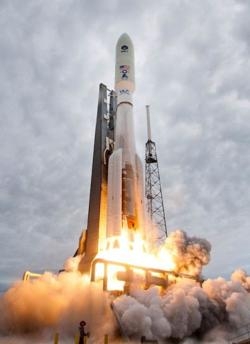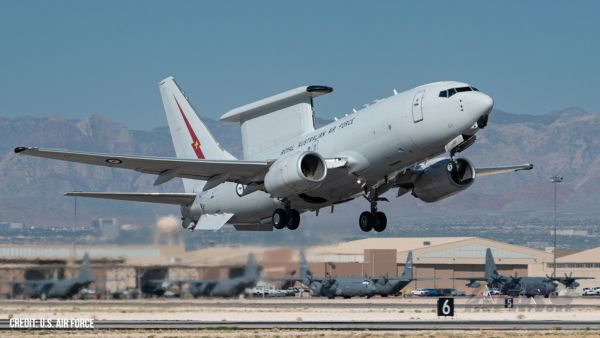Launch Delayed Two Days By Tropical Storm Conditions In Florida
After a two-day delay due to tropical storm conditions, the Navy's fourth Mobile User Objective System (MUOS) satellite launched successfully from Space Launch Complex 41 at Cape Canaveral Air Force Station.

MUOS-4, whose signal was acquired approximately three hours after launch, completes the initial operational constellation and provides near global network coverage for warfighters and combatant commanders. This array allows mobile forces, including submarines, surface ships and aircraft, to communicate around the world via the narrowband spectrum.
User communities that will primarily benefit include ground forces at the individual soldier level but also include members of all services and special forces.
"The legacy satellite communication system allowed users to 'talk' as long as they were within the same satellite footprint," explained Navy Capt. Joe Kan, program manager for the Communications Satellite Program Office. "MUOS allows troops all over the world to talk, text and share mission data seamlessly without having to worry about where they are in relation to a satellite."
The program office falls under the Navy's Program Executive Office for Space Systems, which has responsibility for the MUOS program and is located at the Space and Naval Warfare Systems Command in San Diego.
The Internet Protocol-based nature of MUOS allows network access to classified and unclassified networks. This network access for deployed tactical users will allow the exchange of critical situation awareness and targeting information.
"With the launch of MUOS-4 we're going to deliver that worldwide coverage and communication service for users," explained Nina Tran, the program office's space division director. "The legacy payload we have on MUOS satellites allows a smooth transition to a newer, better MUOS capability. We are benefitting from providing the legacy channels for current users and we are exploring all the capability that MUOS has to offer."
MUOS is an architecture comprised of a five-satellite constellation - a fifth on-orbit spare to be launched in 2016 - four ground stations across the globe, complex software to manage the network and an integrated waveform for use with user radios.
According to the program office's technical director, Jim Parsons, it's the system's flexible design that allows rapid insertion of technology to keep the system up-to-speed.
"The nice thing about MUOS is that the ground system and terminals contain all the switching and routing technology," Parsons said. "The satellite remains unchanged over time and can allow technology insertion into the ground stations and the waveform over time to increase capability without having to make any satellite changes."
Cmdr. Pete Sheehy, principal assistant program manager, explained that 24/7, beyond-line-of-sight communications will greatly benefit ground forces needing aviation support.
"With MUOS, the population of disadvantaged users is going to shrink considerably," Sheehy said. "And that new population of folks who have beyond-line-of-sight communication are going to be able to do their jobs more efficiently and safely. It could be as simple as that one person who otherwise might not have had beyond-line-of-sight comms being able to say 'This is where I am. This is who I am and I need help.' And know that someone is on the other side to be able to provide that support."
MUOS is already providing legacy communications to combatant commanders via active satellites on-orbit. MUOS' advanced capability - Wideband Code Division Multiple Access - has been demonstrated in various environments, platforms and applications such as integration testing with the newest submarine antennas, Navy special operations scenario exercises and Air Force C-17 in-flight tests.
"In our testing we've tried to be as realistic as possible," said Jarratt Mowery, director of end-to-end system testing. "In several events we've brought uniformed warfighters in and given them training on the MUOS system and operating its components. They were able to define the types of operations they would like to use the system and allowed them to exercise those operations in a realistic environment. Be that in vehicles driving around, in a forest with a thick canopy or even in airborne platforms."
An added benefit beyond the system's initial requirements is extending communications further north and south toward the polar regions. This polar coverage, up to approximately 85 degrees in the Arctic under peak conditions, is significant considering that wireless and satellite communications has always been a struggle at extreme north and south latitudes.
Over the next several days MUOS-4 will transition to reach its geosynchronous orbit location approximately 22,000 miles above Earth to begin initial on-orbit testing. The satellite's solar arrays and antennas will then be deployed. On-orbit testing will start for subsequent turn-over to the Navy for test and commissioning to service.
Two MUOS satellites, launched in 2012 and 2013, are already providing legacy communications capability from their geosynchronous orbits over the Pacific Ocean and the United States.
MUOS-3, launched in January, was accepted by the Navy in June after on-orbit testing. The third satellite is awaiting final testing before being accepted for operational use.
Ultimately, the constellation and associated network will extend narrowband communications availability well past 2025.
The Navy's Program Executive Office for Space Systems, located at the Space and Naval Warfare Systems Command in San Diego, is responsible for the MUOS program.
(U.S. Navy image)
 TikToker Arrested After Landing His C182 in Antarctica
TikToker Arrested After Landing His C182 in Antarctica Classic Aero-TV: Versatile AND Practical - The All-Seeing Aeroprakt A-22 LSA
Classic Aero-TV: Versatile AND Practical - The All-Seeing Aeroprakt A-22 LSA ANN's Daily Aero-Term (06.27.25): Hazardous Weather Information
ANN's Daily Aero-Term (06.27.25): Hazardous Weather Information ANN's Daily Aero-Linx (06.27.25)
ANN's Daily Aero-Linx (06.27.25) Aero-News: Quote of the Day (06.27.25)
Aero-News: Quote of the Day (06.27.25)



